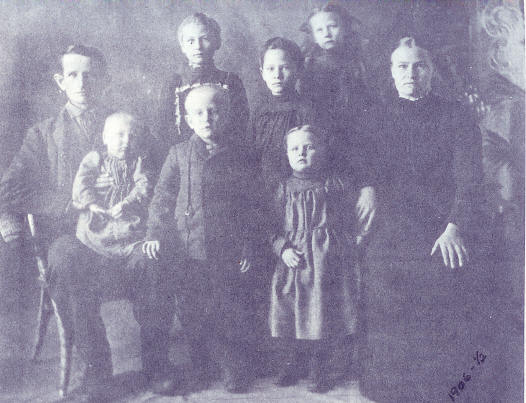- Vader Derk is NH en woont - Bennekom 107, 1871 Veldhuizen 24, 1900-02 idem, 31-12-1902 VSA.
- Moeder Aartje is NH en woont - Renswoude, 21-4-1887 Ede Veldhuizen 24, 1900-02 idem, 31-12-1902 VSA.
- Dochter Hendrika is NH en woont - 1892-1900 Ede Veldhuizen 24, 1900-02 idem, 31-12-1902 VSA.
- Dochter Jannigje is NH en woont - 1895-1900 Ede Veldhuizen 24, 1900-02 idem, 31-12-1902 VSA.
- Zoon Berend is NH en woont - 1896 Ede Veldhuizen 24.
- Dochter Aartje is NH en woont - 1897 Ede Veldhuizen 24.
- Dochter Aartje II is NH en woont - 1898-1900 Ede Veldhuizen 24, 1900-02 idem, 31-12-1902 VSA.
- Dochter Gerritje is NH en woont - 1901-02 Ede Veldhuizen 24, 31-12-1902 VSA.
BLEYENBERG, DERK AND AARTJE (LAGERWY)
In the year 1893, Derk Bleyenberg and Aartje Lagerwy ware united in marriage in the Netherlands. They had a family of five children, four girls and one boy when they decided to move to America in Feb. 1902. The children's names ware Hendrika (Hattie), Jannetje (Jenny), Aartje (Ida), Berend (Ben), and Gerritje (Gertie).
Derk did some farming and bought and sold some cattle. He also peddled milk using a dog to pull the cart.
Seeing there was no future in Holland they decided to take that big step to move to the U.S. Uncle Henry Vonk was already living naar Sioux Center. Uncle William Vander Weide came a year later. They packed their belongings in a trunk, 3 feet wide, 4 feet long, and 3 feet deep. We still have the old trunk.
That trip took at least 5 weeks. The boat trip took about 3 weeks. When they arrived in New York they had to stay at least a day and a night on Ellis Island where all immigrants had health inspection and vaccinations. They must have been at least 3 days on a train. They landed in Maurice, Iowa and had a lunch by Evert Van Maanen. This whole trip must have been quite an experience. Gertie was only 4 months old. As Holland is only about one fourth the size of the state of Iowa, I wonder what went through their minds as they traveled halfway across the U. S. How they got to Sioux Center from Maurice I never heard.

The Derk Bleyenberg family in 1906
Their first home was on the spot where the First Reformed Church is now standing. Father Bleyenberg got a job on the farm of Ed Doornink. That is the land where the Coop Cattle Confinement now is. He walked the four miles twice a day earning $1.00 per day. If the weather looked stable in the evening he sometimes stayed overnight. The people were very tornado conscious, as a big tornado had hit the area a few years before. One evening the weather looked very nice so Dad stayed on the farm. That night a storm struck the community which lasted a large part of the night. Mother with her brood of little ones went to the old Vander Ploeg's house. He was the grandfather of Art Vander Ploeg. Mother and the girls wore wooden shoes, and had left them outside. The next morning there were no "klompen". They had blown away. A big loss, Iím sure. The church building had collapsed during the storm and much damage was done in the area.
We then moved to a house about a block north. Later we moved west across the railroad tracks where Reinard Dykstra now lives. Gerrit was born here.
In the fall of the year Dad worked for Henry Wandscheer who owned a threshing machine. All the grain was stacked in those days. Dad had to pitch the bundles into the machine earning $1.25 per day. They started at sunrise and worked till dark. Sometimes he would stack the straw and got a bonus of $1.00.
The next place we lived was a 120 acre farm across the road of where brother Dick now lives. That is the land where Van Regenmorter has his chicken ranch and where the new housing area is being developed. On this place Dick and Bess were born.
After a few years we moved 3 miles west to the farm where John Vander Hoef lived. It was when we lived here that Dad went to visit the Old Country. I think it was in 1912.
In 1914 we moved near Ireton. In 1929 they had a farm sale and moved to the place where Bert Regenerus now lives. Here Dad passed away on Dec. 9,1938, at the age of 71.
After a few years Mother moved to a house just east of the Standard Station. This is now a parking area of Case Van Velsen. Here Mother passed away on April 2, 1946, at the age of 73.
NOTE: This story was written by Ben Bleyenberg as he remembers their history and was read at a Bleyenberg get-together on Nov. 7, 1980.
Submitted by Wilmyna Jansma